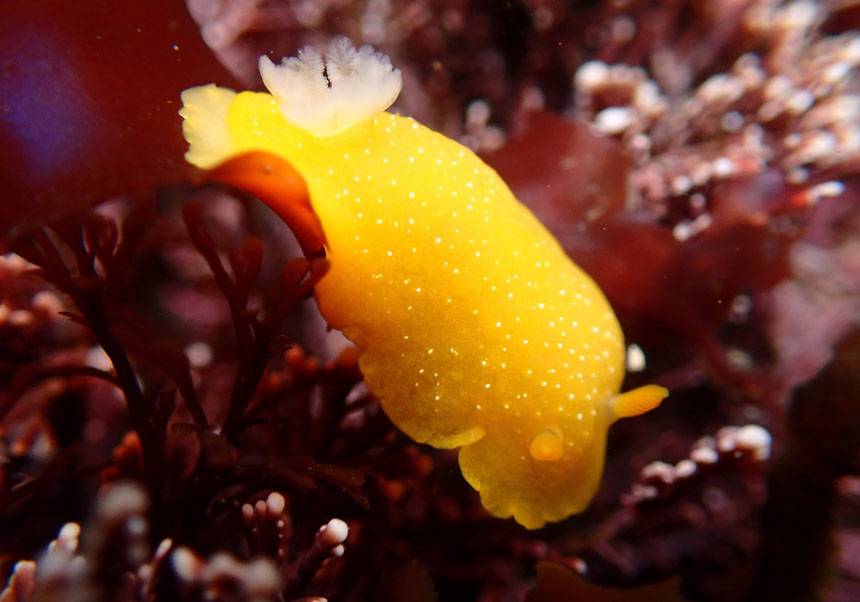Users
Social media
- More details here...
- Address
Parc Científic de la Universitat de València C/
Catedrático Agustín Escardino, 9
46980 Paterna (Valencia) Spain - Email:
iu.i2sysbio@uv.es - Phone:
(+34) 963544810
- Address
Links
A new technique allows bacteria with pharmaceutical interest to be found in sea slugs for the first time

Investigation
Thesis
A new technique allows bacteria with pharmaceutical interest to be found in sea slugs for the first time
An international research team involving the Institute of Integrative Systems Biology (I2SysBio), a joint center of the Higher Council for Scientific Research (CSIC) and the University of Valencia (UV), has just published in the journal Microbiome a study that reveals the presence of beta-lactones, a group of little-studied substances with pharmaceutical potential generated by symbiotic bacteria that live in the skin of a species of nudibranch, a sea slug. It is the first time that a compound of pharmacological interest has been found in this group of mollusks, through an innovative technique that promises to expand the knowledge of this type of substances of bacterial origin. Doriopsilla fulva was used in the study. Credits: Mária Džunková. Nudibranchs comprise a group of more than 6,000 species of soft-bodied marine mollusks known as “sea slugs.” They use secondary metabolites (natural substances) for their chemical defense, but the full diversity of these substances remains unexplored, so their potential therapeutic applications are unknown. the genomes of uncultured microbes using computational tools, but there are no guarantees that the genes detected are functional. During her postdoc in the United States at the Lawrence Berkeley National Laboratory, Mária Džunková used a fluorescent probe developed at the University of California, San Diego to label bacteria that produce natural products. microbes inhabiting the nudibranch Doriopsilla fulva using fluorescence-activated cell sorting (FACS) and microbial single-cell genomics. With this technique, the bacteria that have absorbed the fluorescent probe are collected and the DNA present in single cells is amplified. This allows obtaining sufficient quantities for the sequencing of the complete genome of each separated cell, which allows the identification of new bacterial species without the need to cultivate them in the laboratory. With this new technique he discovered the presence of the non-culturable bacteria Candidatus Doriopsillibacter californiensis, which belongs to an order of non-culturable bacteria. “This bacteria has genes for the production of beta-lactones, a little-explored molecular group with pharmaceutical potential that had not been detected in nudibranchs before,” says the researcher. “Future research will reveal whether it is possible to use this compound to treat diseases such as cancer or infections caused by viruses or bacteria,” reveals Džunková. According to the Slovak researcher, who joined the I2SysBio to create its microbial single cell genomics research group, “this is the first study to document a natural product from symbiotic microbes that live in the skin of nudibranchs.” style="margin-bottom:11px; text-align:justify"> Analyze other species of nudibranchs from Spain His team analyzed the microbial composition of several individuals of the nudibranch Doriopsilla fulva, found off the coast of San Francisco (California, USA), and confirmed that the bacteria Candidatus Doriopsillibacter californiensis is the most important member of the microbial community on their skin. The Extracts from this nudibranch contained natural products consistent with the beta-lactone found in its symbiotic bacteria. Since it is a non-culturable bacteria, the Lawrence Berkeley National Laboratory team has used a new synthetic biology method called CRAGE (Chassis-independent Recombinase-Assisted Genome Engineering) developed in this laboratory, and they are trying to recover the complete molecule. Meanwhile, the I2SysBio team analyzes other species of nudibranchs from Spain (Galicia, the Basque Country, Andalusia and the Balearic Islands) and tries to discover more bacteria by producing molecules of pharmaceutical interest. Reference: Microbiome 11, 130 (2023). style="color:#0563c1; text-decoration:underline">https://doi.org/10.1186/s40168-023-01560-8 Caption attached:
Images:





